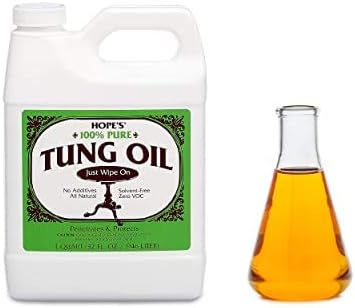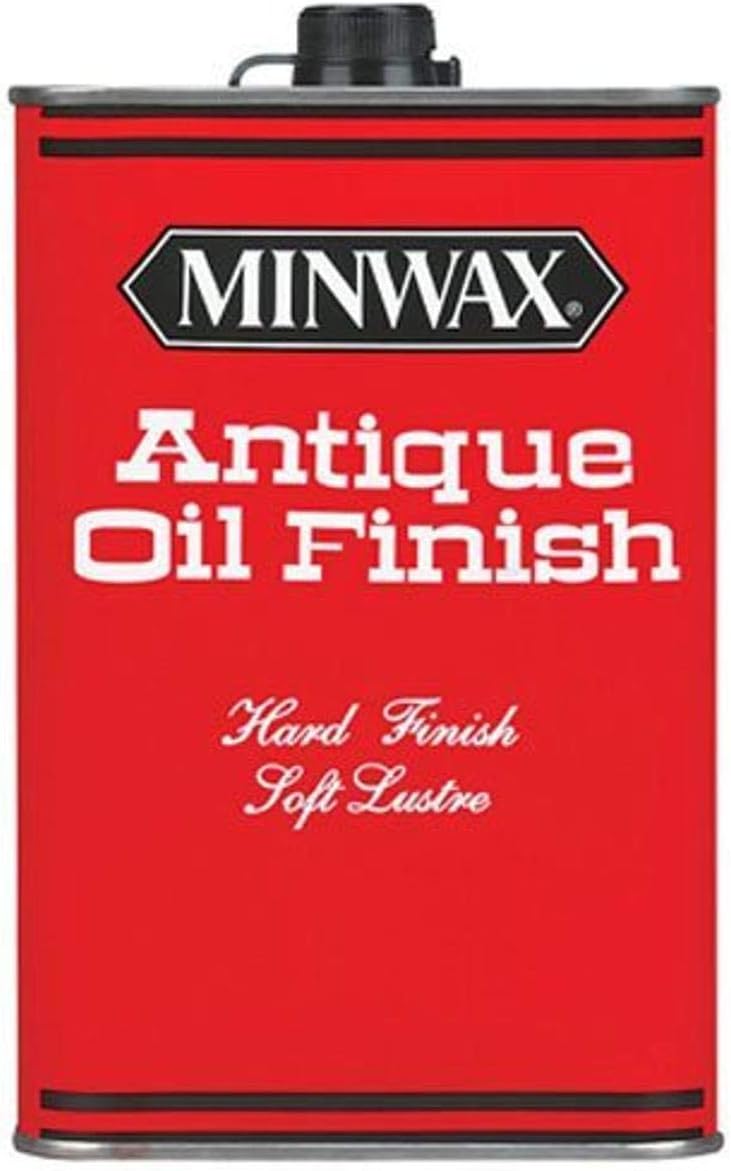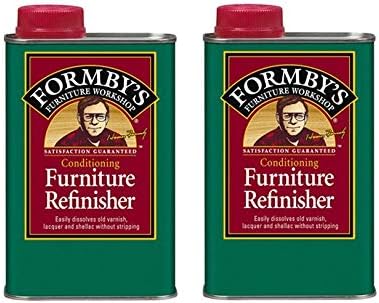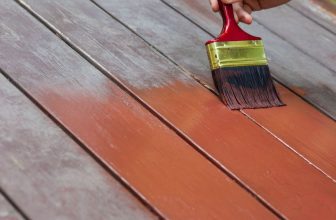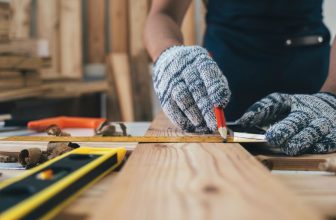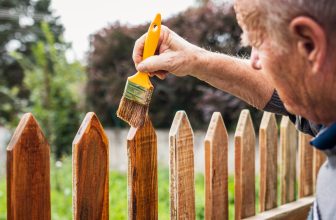Contents
Wood is one of the most beautiful building materials, with a natural look and gorgeous grain pattern. However, its beauty tends to wear down with use and exposure to air and moisture. The last thing you want is to pour your heart and soul into a project, only to have it looking old and faded in a few months. Thankfully, wood oil can help protect your work and maintain its visual appeal.
Not all wood oils are suitable for every project, so I put together these reviews and an in-depth buyer’s guide for choosing the best one for your purposes.
Best Oils for Wood – Top Picks
BuildEazy.com may earn a commission if you purchase a product through one of our links.
Hope’s specializes in natural, protective finishes for a variety of surfaces around the home and for the automotive industry.
This is a 100% tung oil that is thin, pourable, and very straightforward to apply. Unlike linseed oil, it is safe to let air dry and isn’t combustible. I’ll discuss this more in-depth in the buyer’s section below.
I recommend wiping this onto your wood with a clean rag for the best results. Massaging it into the grain is the best way to get even coverage, so plan to put some elbow grease behind this oil.
Tung oil naturally hardens when it comes in contact with air, so this product will provide some physical protection for your work. It will resist minor scratching and scuffing to keep your project looking newer for longer.
It seeps between the grain of your wood and is naturally hydrophobic, so it does an excellent job of waterproofing.
It takes a long time to dry, primarily because it soaks deep into the wood grain. You should expect to wait 12-24 hours before applying additional coats. The long dry time will make your finishing process take longer, but I think the results are worth the wait.
It will darken the color of your wood a bit and add a nearly imperceptible shade of yellow. It looks stunning on more expensive wood species, like maple, oak, walnut, and teak. It will make the surface look wet, so the grain will pop and be much more noticeable once this oil dries. It doesn’t offer any sheen, helping to maintain the natural beauty of the wood.
This oil is uncut, so it doesn’t contain any harmful components. It has no volatile organic compounds (VOCs), is non-toxic, and is perfectly safe to apply without protective gear. It’s 100% natural, which makes it food safe. You can use this on cutting boards, wooden utensils, dining tables, and any other surfaces that may contact food or beverages.
It comes in a large, 32-ounce jug, has excellent coverage, and is very affordable.
Minwax Antique Oil Finish
Minwax is a well-known and trusted brand in the woodworking industry for its stains, wood finishes, and sealers.
This is an oil-based finish made primarily of linseed oil, mineral spirits, and some other protective additives. It’s fairly straightforward to apply with a clean rag, but you will need to put some effort into rubbing it into the grain.
It hardens partially on the surface of the wood and offers excellent physical protection. The protection layer seems durable, so I trust that it will stand up to handling, light foot traffic, scratching, and other damage.
What doesn’t harden on the surface sinks into the wood grain and provides a water-resistant layer of defense. This will help limit damage and staining from spills, moisture, and other liquids.
It dries rapidly and will be safe to touch within about 10 minutes. However, Minwax recommends you wait 24 hours between coats for the best results.
It will darken your wood surface a bit and make it appear wet. The grain will become pronounced, so it’s especially beautiful on high-quality and rare wood species with interesting grain patterns. I didn’t notice any discoloration at all during testing.
It has some constituent that creates a delicate luster, not unlike a varnish with a satin finish. The result is quite remarkable, and it will really enhance the appeal of your projects.
This product contains a low VOC concentration, but I still recommend wearing a face mask when using it. The odor is minimal, but keeping your space adequately ventilated will minimize the lingering smell. This is not food-safe, so it isn’t suitable for cutting boards, butcher blocks, or other surfaces that will contact food.
It comes in 1-pint and 1-quart cans and is very affordable. It has excellent coverage, so it’s suitable for small and large projects.
RUST-OLEUM Watco A67141 Teak Oil Finish
Rust-Oleum produces a wide range of durable finishing products for wood, metal, concrete, and many other mediums.
This product has a linseed oil base, and it contains some other constituents to help it dry and harden more quickly. It’s very straightforward to apply with a clean rag or a brush. I recommend wiping this on with some force for the best penetration possible.
Teak oils are usually tung or linseed oils with added polymers that create a durable protective layer over your surface. This linseed oil-based finish does just that, so it can protect your projects from physical damage like light scratches and scuffs.
It soaks into the grain with proper application and creates a water-resistant barrier for your project. It’s made for wood on boats that sits above the waterline, so you can be sure it will help reduce water damage and staining. As such, it’s ideal for use on outdoor projects and will keep them defended against the elements.
It contains UV blockers to reduce fading from exposure to sunlight, making it ideal for outdoor projects or regularly in the sun.
This oil dries to the touch in about eight hours. This means you could potentially apply two coats in just one day, reducing the overall project time.
It has some restorative properties, so it will change your wood’s appearance back to what it was when new. This is noticeable mostly on high-end wood species like teak and mahogany, where the transformation from old and faded to beautiful and fresh is quite astounding.
It contains some VOCs, so you should avoid inhaling the vapors. I recommend wearing a face mask and gloves when using this product. It isn’t food safe, so avoid using this on projects that may contact food or beverages.
It comes in 1-quart cans, each of which will cover about 170 square feet. This oil is reasonably priced and offers good value for the money, especially if you’re looking for UV protection for your projects.
Sunnyside Corporation 87232S Boiled Linseed Oil
Sunnyside Corporation offers numerous treatments, paint thinners, and varnish strippers for preparing and finishing wood.
This is a boiled linseed oil, but it hasn’t been heat-treated and instead includes chemicals that speed up the drying process. It’s straightforward to apply and just takes some effort to rub it into the grain of your wood. I recommend wearing gloves and using a rag to apply this product. I will go over this in greater depth in the buyer’s guide below, but you need to take very special care to dispose of the rags you use properly, as they can cause fires.
This oil will harden as it dries, providing some minor defense to physical damage once it has cured. It won’t stand up quite as well as many other options to scratching and scuffing.
This product is naturally water-resistant, and it provides enough protection from liquids and moisture to be suitable for outdoor projects. However, it doesn’t include any UV blockers, so it won’t stop your wood from fading in response to sun exposure over time.
It dries very slowly because it takes quite a while to sink into the wood grain. It’s ready to be re-coated in about 18 hours, but I’d recommend waiting at least 24 for hardwoods due to the tighter grain structure.
It will darken your project’s appearance a bit, but it doesn’t cause any noticeable discoloration. It makes your wood’s grain stand out beautifully. The polymers dissolved in this formula dry to create a light, natural-looking luster, so you can expect just a touch of shine to accentuate the beauty of your project.
This oil contains volatile organic compounds (VOCs), and the vapors aren’t safe to inhale. I strongly recommend wearing a mask and gloves while applying it. The odor is reasonably powerful, so it’s best used outdoors or in an area with adequate ventilation.
It comes in 1-quart jugs that are reasonably priced. The containers are plastic and are more likely to crack or break than metal cans.
Tried and True Original Wood Finish
Tried and True manufactures various all-natural, non-toxic wood finishes designed to elevate the medium’s natural beauty.
This product has a boiled linseed oil base and is combined with beeswax. The result is a relatively thick formula that can be a bit challenging to apply. The beeswax makes it significantly more viscous than standard linseed oil, so you’ll have to put a bit more effort into rubbing this into the grain.
I recommend using a rag to apply this oil. Ensure that you dispose of the rag properly. I’ll include details in the buyer’s guide on linseed oil’s ability to combust spontaneously.
Some of the linseed oil will remain in the beeswax on the surface of your project, and it naturally hardens as it dries. It leaves a protective film on top of your wood that will defend against light physical damage.
Both the oil and the wax offer protection from water. You can use this product on indoor or outdoor projects, but I found that the water resistance isn’t quite as good as some other oils that include polymers for protection.
This oil dries very slowly, so you should expect to wait about 24 hours before re-coating. This means your finishing process will take several days if you plan on 2-3 coats.
It dries completely clear and won’t change the color of your wood at all. It will leave it with a beautiful wet, healthy appearance that brings out the grain nicely. This is an excellent option for all types of wood, as it provides a very naturally enhanced appearance.
This oil is 100% natural, non-toxic, and safe to apply without any protective gear. I do recommend wearing gloves, only because it can be challenging to wash off of your hands. This product is food safe, so you can use it around pets, children, and surfaces that come in contact with food and beverages.
It comes in 1-gallon, 1-pint, and 1-quart cans, all of which offer impressive coverage. It is very costly and might be prohibitively expensive for larger projects.
Formby 30064 60064000 Low Gloss Tung Oil Finish
Formby’s manufactures finishes, polishes, and cleaners to seal and maintain the wood’s natural beauty.
This product has a tung oil base, and it includes a variety of other compounds to aid in drying and protective qualities. It’s relatively easy to apply this oil with a rag, but you’ll need to massage it in with some force for the best penetration.
Tung oil naturally hardens to provide a protective coating, and this finish also contains hydrocarbons that create better durability once cured. As such, this product will provide better defense than 100% tung oil.
The barrier it forms on and under the surface of your wood will naturally resist water, so this is a good option for indoor and outdoor projects. It resists mildew, making it suitable for use in areas with high levels of moisture. However, it doesn’t block UV radiation from damaging or fading the wood.
It dries very slowly because it soaks deep into the grain of your project. I recommend waiting at least 24 hours before re-coating or handling your workpiece.
The oil will darken your wood quite a bit, and the tung oil can cause some minor discoloration. It often adds a light yellow hue to the surface that many woodworkers find attractive. I recommend testing it in an inconspicuous area of your project or a piece of scrap wood to see how it changes the appearance.
It contains volatile organic compounds, so the vapors are dangerous to inhale. I strongly recommend wearing a face mask. It can cause some skin irritation, so I suggest wearing gloves will keep your hands protected. This product is not food safe and should be kept away from cutting boards or other surfaces that will be near food.
This comes in 16-ounce cans that supply decent coverage. However, this product is exceptionally expensive, so you’ll have to consider the cost carefully when deciding if this oil is suitable for larger projects.
Cabot 140.0003400.005 Australian Timber Oil
Cabot offers many different high-quality wood stains and finishes for a professional appearance and adequate protection from the elements.
This is an oil-based stain containing linseed oil, tung oil, alkyds, and other chemical additives to increase its protective qualities. You can apply this with a rag, but Cabot recommends a lambswool applicator, which will add to your overall cost. I did find that the job was made a bit easier with the higher-quality staining pad.
It’s formulated to add comprehensive protection to your wood projects. The linseed oil and alkyds naturally harden on the surface to protect it from scratches, scuffs, and other minor physical damage. The tung oil seeps deeply into the grain and adds a robust, water-resistant layer.
It contains UV blockers that will protect your wood from the damaging effects of sunlight. As such, this is a great product to use on both indoor and outdoor surfaces, given how well it resists the elements.
It takes a long time for this oil mixture to dry, so you’ll need to wait about 24-48 hours before handling your project or exposing it to rain or sunlight. Water spots will form quickly on the surface if it gets wet before it has cured, so I suggest checking the weather before you begin if you’re working on exterior projects.
This is a stain, so it will change the appearance of your wood. There are multiple colors you can choose from to match your wood. Even the natural option will alter the color a bit, so I recommend using it on a scrap wood piece before committing to applying it on an entire project.
This oil contains a relatively high concentration of VOCs, so you should take great care when using it not to inhale the vapors. A face mask or respirator is required, and gloves will help keep your skin protected from any resulting irritation from contact. This product is not food safe and shouldn’t be used on cutting boards, butcher blocks, prep tables, or any other surfaces that will contact food.
It comes in 1-quart and 1-gallon cans. It’s relatively expensive, but it offers excellent coverage and provides good value for the money.
Watco 266634 Tung Oil
Watco is a line of natural-looking wood finishes made by Rust-Oleum.
This is a tung oil-based product that contains several chemicals to aid in the drying and bonding properties. You can apply this with a rag to rub it into the grain, and I strongly recommend wearing latex gloves to do so to avoid skin irritation.
The tung oil soaks into the wood and provides excellent protection from water and moisture. You could use this on outdoor projects, but note that it won’t protect your wood from fading in response to direct sunlight.
Some of the product does remain on the surface, where it cures and hardens to create a thin, protective layer. It will help defend your project from scratching, scuffing, and other damage. However, it isn’t durable enough for areas expected to get regular foot traffic. I found that it wore down more quickly on regularly handled surfaces – like handrails – than other options.
It takes about 24 hours to dry before it’s ready for re-coating, which means finishing your project will likely take several days. This can be inconvenient depending on your schedule and the weather. However, the added ingredients do allow this product to dry faster than pure tung oil.
It won’t darken the shade or color of your wood at all, so you can apply multiple coats without worrying about changing the appearance of your project. The first coat will make the grain pattern pop, and each additional coat will improve the sheen and add a bit more protection.
This product contains VOCs, so you need to handle it with care. I strongly recommend wearing a mask and gloves when using this. The volatile organic compounds make this unsuitable for use on surfaces that will contact food or beverages.
It comes in 1-quart cans and is relatively expensive, but it provides excellent coverage.
Watco 242219 Danish Oil Wood Finish
This is Danish oil, which is a mixture of tung oil, hardening constituents, and a thinner. The thinner makes it effortless to apply, but I still recommend rubbing it into the surface with some force to get the best, most even application.
The tung oil and the included varnish cure to create a durable, protective finish over your project. It will protect against scratches, scuffs, and other physical damage better than most other options.
The tung oil soaks into the wood grain to develop a protective barrier beneath the surface. It’s naturally hydrophobic and will resist water and moisture damage, keeping your wood looking newer for longer. The protection from liquid makes it suitable for outdoor use, but it doesn’t have UV blockers to prevent fading from sun damage.
It will be dry to the touch in about six hours, but I recommend letting it cure for at least 12 before re-coating to ensure it sets thoroughly.
Danish oils naturally darken the wood to which they are applied, so you can expect this product to do the same to your projects. It will still accentuate the grain pattern and leave it visible, but the color of your wood will be drastically altered as well, similar to the result of using a light stain. Check out the video below for an idea of how this product looks once applied:
This oil contains relatively few VOCs, but I still strongly recommend wearing a mask. Gloves will help limit skin exposure and reduce the chance of irritation. It has a relatively strong odor, so it’s best for application outside or in a heavily-ventilated area.Requires some force for good penetrationThis oil contains relatively few VOCs, but I still strongly recommend wearing a mask. Gloves will help limit skin exposure and reduce the chance of irritation. It has a relatively strong odor, so it’s best for application outside or in a heavily-ventilated area.
This oil comes in 1-pint cans, and it is costly. It has good coverage, but it will likely be cost-prohibitive for larger projects.
Star Brite Premium Golden Teak Oil
Star Brite offers numerous finishes for wood that are geared toward restorative and outdoor projects.
This is a teak oil, which is a mixture of tung oil, chemically modified linseed oil, and some other constituents to aid in the drying process. You can wipe this into the surface of your project with a rag just like most other wood oils, and you’ll need to apply some force to get the best penetration. As is the case with any product containing linseed oil, you need to take special care to dispose of the rags used to apply it.
The linseed oil and a portion of the tung oil will dry on top of your wood, creating a protective surface. It will keep your project safe from light scratches and scuffs.
Most of the tung oil will soak into the wood grain and create a water-resistant barrier. This will repel water and help keep moisture out, extending the life and beauty of the wood to which you apply it. This product also contains UV blockers, so it will protect the wood from fading over time. As such, it’s an excellent option for outdoor projects.
Star Brite recommends applying and wiping clean within five minutes. The surface will then be dry to the touch, but I recommend waiting at least 24 hours before exposing your wood to the elements, just to be sure that oils have cured.
This product is meant to be restorative, so it will enhance the natural color of your wood. However, it is transparent and won’t discolor the surface or leave a sheen behind. It makes the grain pattern look rich and deep, so it’s ideal for high-quality wood with attractive grain patterns.
It contains volatile organic compounds, so you should avoid inhaling the vapors. I recommend wearing a mask, eye protection, and gloves when using this oil, as it is an eye and skin irritant. You should not use this on projects intended for food contact.
It comes in 32-ounce bottles, which are relatively expensive. However, you can get excellent coverage out of just one container.
OSMO Top Oil Stain
OSMO manufactures several wood finishes and cleaners, including polyurethanes, sealers, and oils.
This is a mixture of natural oils and waxes that is thick and relatively straightforward to apply. The wax makes it a bit thicker than many other options, so you’ll have to put more effort into rubbing this one into the grain. I suggest using a clean rag to wipe onto your wood.
The mixture hardens partially on the surface, creating a delicate protective barrier. It won’t stand up to as much physical abuse as many other oils, but it offers some resistance to scratching and scuffing.
The constituents naturally repel water, so you can expect your project to be safe from spills, moisture, and rain. Liquids bead up on the surface, so you can see it working and will be able to tell when your wood needs a new coat.
It dries to the touch in about 10-12 hours, but I recommend waiting 24-48 hours to ensure it has cured thoroughly. The slow drying properties will make your projects more time-consuming.
This coating is entirely transparent and won’t add any color to your wood. It will help accentuate the natural beauty a bit by highlighting the grain pattern and offering a wet look, but it doesn’t stand out quite as much as many other wood oils I tested. There is no sheen to the finish, which makes this product suitable for imperfect surfaces.
This is made from entirely natural ingredients that are non-toxic and contain no VOCs. This product is safe to apply without gloves or a face mask, and it’s safe for use around children and pets. It’s also food-safe, so you can use this on cutting boards or other food preparation surfaces.
It comes in 1-pint cans, which are very expensive. The price may be justifiable if you’re looking for a food-safe option with little odor, but it might be prohibitively expensive for larger projects.
Buyer’s Guide
It can be challenging to choose the best wood oil for your projects because every product offers varying protection and appearance. Make sure to consider the below common constituents before purchasing a wood oil.
Why You Should Oil Wood Furniture
Wood oil is an excellent finishing option for wood projects because it can offer multiple layers of protection. Different oils can prevent scratching and other physical damage, they provide a water-resistant barrier to defend against liquids and moisture, and some offer UV protection to prevent your wood from getting faded from sun exposure.
Oils enhance the natural beauty of your wood and won’t leave a shiny appearance on the surface. They make the grain pop without making it look overly-processed.
They’re relatively straightforward to apply, and you’re unlikely to get imperfections because they soak into the wood. This makes them great for beginners and experienced woodworkers.
Types of Oils
There are many different types of oils that are common in finishing products. Each offers different benefits and can add to the challenge of the application.
Oil and Varnish Blend
Blends of oils and varnish add water-resistance and very durable physical protection. They typically have a higher concentration of VOCs than other options, so they are generally less safe to use.
Wax
Beeswax and other natural waxes are impractical to use as a standalone finish because they’re far too hard on their own and can’t be rubbed onto wood surfaces. However, they make great additives to oils and help create a protective shell that keeps your wood moist and healthy. These waxes are great for adding to food-safe finishes.
Tung Oil
Tung oil comes from the Tung tree and naturally hardens when it comes in contact with air. It can protect your wood from physical damage as well as create a waterproof barrier, and it’s food-safe if used by itself. However, it takes several days to cure, so it’s often mixed with chemicals to speed up the drying process. Check out the video below for tips on diluting:
Olive Oil
Olive oil is a cheap option that brings out your wood’s grain pattern and helps keep it looking healthy. However, it doesn’t harden at all and won’t add more protection than some natural water-resistance. It is entirely food safe.
Mineral Oil
Mineral oil dries somewhat quickly, requiring regular reapplication. It will improve your wood’s appearance and keep it moist, but it usually needs to be sealed with a beeswax mixture to maintain the look and health benefits. Pure mineral oil is food safe.
Walnut Oil
Walnut oil hardens a bit as it dries, so it will offer some damage protection along with water resistance. It is suitable for use on cutting boards and other surfaces that come in contact with food. It takes several days to dry, so it will extend your overall working time.
Check out this video to see how it compares to some other more popular wood oils:
Danish Oil
Danish oil is a mixture of tung oil, polymers or other hardening chemicals, and a thinner. It is not food-safe, but it adds excellent physical protection and water-resistance. It significantly darkens the wood surface to which it’s applied, similar to a light stain. Check out the video below to get an idea of how much the surface color can change:
Linseed Oil
Linseed oil takes a very long time to dry but forms a durable coating on top of the wood surface. Most linseed oils are boiled or treated with chemicals to bring down the drying time. Pure or heat-treated linseed oil without additives is food safe.
Be very careful when using this product, as linseed oil can spontaneously combust. It heats up as it dries, so concentrated amounts on leftover rags can catch fire without a spark, making it potentially dangerous and life-threatening. Always rinse rags thoroughly with water after use and lay them out flat to dry. It is perfectly safe when applied to wood and won’t cause any problems when spread out on a surface.
Teak Oil
Teak oil is a mixture of either tung or linseed oil with chemicals to speed up the curing process. It is not food-safe, but it does protect from damage, water, and moisture.
Other Finishes
There are various other finishes you can choose from, like shellac, lacquer, and polyurethane. These are far less natural than wood oils, contain more VOCs, and are not food safe.
Oil Vs. Varnish
Wood oil provides a more natural look to your project, highlighting the grain pattern without adding a shiny finish that often looks overly processed. Natural wood oils can be food-safe, and most add a layer of protection from physical damage as well as water and moisture.
Varnishes like lacquer, polyurethane, and shellac, add far more protection, but they give your piece a less natural appearance. They can make imperfections in your wood stand out, and high-shine options can make your project look overly processed.
Check out the video below for advice on choosing between varnishes and oils:
Frequently Asked Questions
Can Jojoba Oil Be Used On Wood?
Regardless of whether you want a more natural alternative to protecting your wood furniture with a protective coat or you simply don’t have any of your usual wood protection products – jojoba oil is a natural and effective way to protect your wood furniture from becoming damaged.
Not only that, but for added convenience, you can even use jojoba oil to shine and protect a variety of other household surfaces, including door beams, non-fabric furniture, frames, handles, windowsills, kitchen countertops, and just about anything else that you can think of.
Wondering how to use it, though? If you have yet to use jojoba oil and you’re planning on sealing your wooden furniture with it for the first time, the nest assured that applying jojoba oil is super simple and will take just a few minutes.
Prior to coating your wood furniture with your chosen jojoba oil, you will first need to make sure that the area surrounding the wood furniture has been cleaned and all additional furniture items have been moved to a temporary location so that they will not get in the way while you are conditioning your wood surface with the oil.
From there, all you will then need to do is take a soft cloth and saturate it in your jojoba oil, before then proceeding to coat the entirety of your wooden surface with the oil.
In order to make sure that you are able to effectively coat your unsealed would evenly the first time, w recommend that you glide the cloth in a sweeping motion all along the surface of the wood (from corner to corner) until you are happy that every part of the wood has been covered with the oil.
After you have finished doing this, all you will then need to do is allow the jojoba oil to be absorbed into the surface of the wood.
For the best results, we recommend that you allow the jojoba oil to saturate itself inside the wood for a period of around 24 hours before proceeding to begin using the wooden surface as normal.
By ensuring that you do this, you will help to raise the overall efficacy of the jojoba protective coating and reduce the chances of the oil piling or being removed from certain spots across the surface before it has even had time to dry.
In need of a recommendation? No problem! If you do not currently have any jojoba oil but are interested in using some to shine, condition, and protect your unsealed furniture – then we recommend checking out the Cliganic Jojoba Oil, which is 100% pure and entirely free of GMO.
Can You Use Vegetable Oil On Wood?
Alongside using jojoba oil as a way to condition and protect an unsealed wood surface, vegetable oil is another fantastic oil that will be able to effectively and efficiently seal your wooden surface without the need for any harsh sealing products!
The best part about using vegetable oil to seal your wood is that you can use any kind of vegetable oil that you like, although most people prefer to use olive oil due to its ability to coat the wood for a longer period of time.
In order to use your vegetable oil to condition your wood, simply take a dry cloth with some oil, and begin massaging it over the surface of your wood in circular motions.
Can I Use Coconut Oil On Wood?
Yes, you can use coconut oil on wood! Believe it or not, coconut oil is one of the best conditioners that you can use wood, and just so happens to be one of the most affordable wood conditioners on the market, too.
When used correctly to condition wooden furniture, coconut oil will not only be able to impart a high shine and keep your wooden surfaces moisturized – but coconut oil will also be able to prevent it from warping, too!
Thanks to this, it means that if you plan on using coconut oil regularly to condition your wooden surfaces, it will help to ensure that your wood furniture stays pristine for a longer period of time before needing to be replaced.
Planning on trying coconut oil for yourself?
If you would like to use coconut oil to condition your wooden furniture, then all you are going to need to do is simply take some warmed coconut oil and a clean cloth – and then begin massaging the oil into the surface of your wooden furniture.
For best results, we recommend that you do this every 2-3 weeks.
Can You Use Baby Oil On Wood?
While baby oil isn’t deemed the best for sealing wood furniture – it is considered to be a great option for shining wood surfaces!
If you’re interested in using baby oil to condition and shine your wood furniture – then all you will need to do is simply take a clean, soft cloth and apply a few drops of baby oil onto the cloth.
Once you have done this, all you will then need to do is gently wipe down your wooden surface of choice until you can see a dazzling shine! It’s as simple and as easy as that.
Is Teak Oil The Same As Linseed Oil?
If you’re planning on conditioning your unsealed wood with oil, then you might currently be wondering what the difference is between linseed oil and teak oil.
Even though you might have heard that the two are more or less the same when it comes to sealing, conditioning, and protecting wood – it is important to keep in mind that the two types of oil are quite different.
On one hand, you have the option of using linseed oil in order to condition and seal your wood.
Regarded as being one of the best oils for sealing wood surfaces, linseed oil is very good at being a protective topcoat across the surface of wood furniture, linseed oil (when applied correctly) will be able to prevent your wooden surfaces from becoming damaged from everyday wear and tear.
However, even though teak oil is very effective in acting as a protective top layer, teak oil, if not given enough time to dry, will remain very tacky and sticky.
On the other hand, you also have the option of using linseed oil, which is also deemed as being one of the best oils for use across unsealed wooden surfaces.
Unlike teak oil, linseed oil is known to dry very quickly, although there is a chance that it might stain wood surfaces with a darker tone due to how quickly it absorbs.
Keep in mind that this is most apparent in lighter shades of wood as well as wood surfaces that are highly porous, such as oak.
Conclusion: Which Wood Oil is Best?
Wood oils come in many varieties, so no single product will be ideal for all projects. They offer different levels of protection, their drying time can vary from several hours to multiple days, and some are food safe.
My favorite wood oil is Hope’s 100% Pure Tung Oil, Moisture Resistant Wood Finish. It does take quite a long time to dry, but it leaves behind a hard layer to protect the surface, seeps into the wood to add water-resistance, is food-safe, and brings out the natural beauty of the wood.

